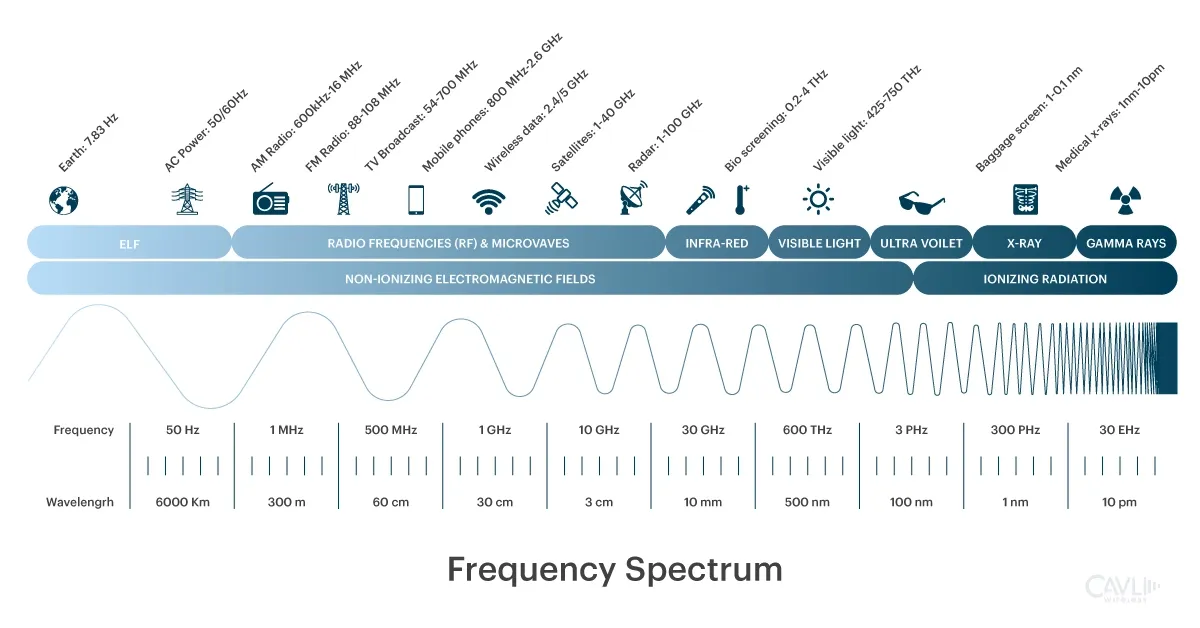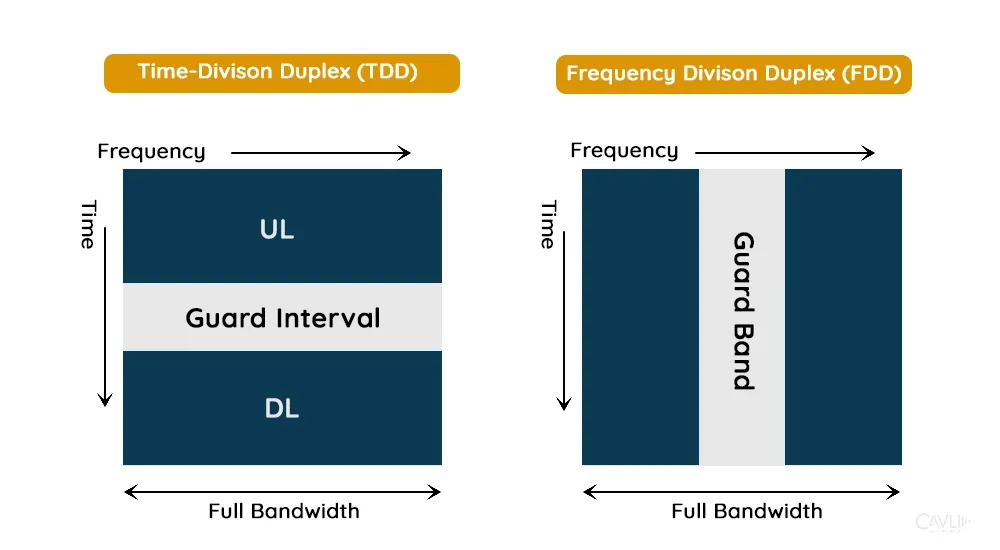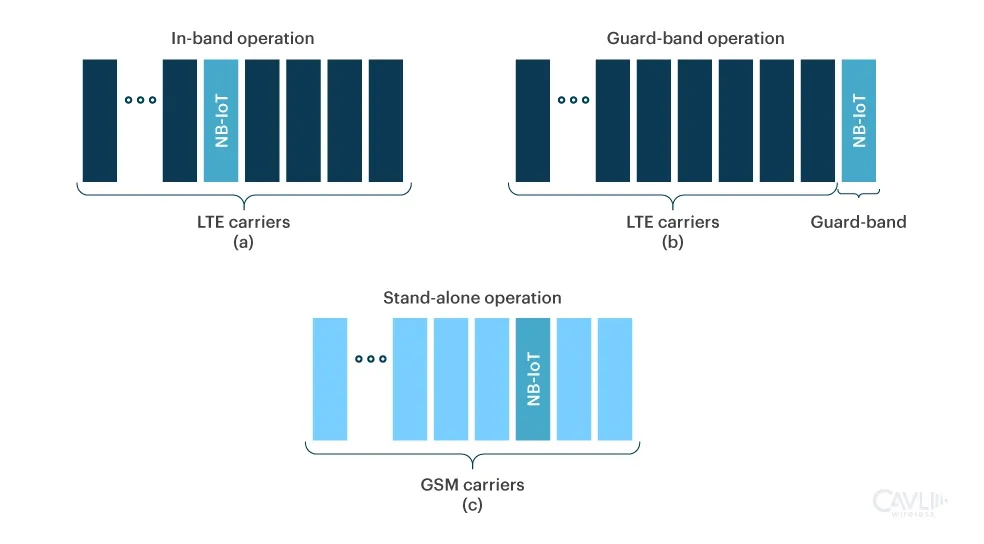James, Jr. Network Engineer
Hi, I was researching frequency bands used in cellular wireless communications and I came across several bands and classifications. Can you educate me on this?
Adam, Network Engineer
Sure, let’s get into understanding the frequency bands. Different frequencies in the EM spectrum are used for different applications around us. For example, telecommunications, FM/AM, and satellite communications all utilize the frequency spectrum spread from 3 kHz to 300 GHz.
James, Jr. Network Engineer
When dealing with the frequency spectrum, there is a mention of different sections in radio frequencies from 3 Hz to 3 THz. Can you explain this classification?
Adam, Network Engineer
RF is the low frequency spectrum used for wireless communication systems. It is divided into various bands namely- Extremely low frequency (ELF), Super low frequency (SLF), Ultra-low frequency (ULF), Very low frequency (VLF), Low frequency (LF), Medium frequency (MF), High frequency (HF), Very high frequency (VHF), Ultra high frequency (UHF), Super high frequency (SHF), Extremely high frequency (EHF), and Terahertz high frequency (THF).
James, Jr. Network Engineer
Great. Now when stepping into the Cellular IoT connectivity domain, what frequencies are used specifically for IoT devices?
Adam, Network Engineer
Cellular IoT connectivity taps into the UHF (300 MHz to 3 GHz) and SHF (3 GHz to 30 GHz) RF spectrum bands. GSM standards traditionally operate between 900 and 1800 MHz for IoT. Meanwhile, 4G LTE covers from 600 MHz to 2.6 GHz, and next-gen 5G networks extend to 30 GHz using millimeter-wave bands.
As Adam still has questions in his quiver, you would also be curious to demystify what frequencies are used in your IoT devices and how it is changing with the intervention of new network generations. In this blog let's talk about LTE cellular frequency bands and how they aid IoT connectivity.
Exploring Cellular Frequency Bands in Modern Connectivity: Understanding the Radio Spectrum
In the late 19th century, Heinrich Rudolf Hertz demonstrated the existence of the electromagnetic spectrum, marking a pivotal moment in the evolution of communication. Today, cellular IoT leverages these cellular frequency bands to enable seamless communication between countless connected devices within a connected network.

Later in the 1990s, cellular network technologies such as 2G (GSM, GPRS) became widespread. They were used for the earliest types of IoT applications, by utilizing 900 MHz and 1800 MHz bands in many parts of the world.
In Mid-2000s with the advent of 3G, higher data rates became available, enhancing capabilities for more data-intensive IoT applications. Frequencies around 2.1 GHz (part of the UHF band) started being used more extensively for IoT, enabling better transmission of real-time data and supporting more sophisticated applications in healthcare, logistics, and smarter cities.
The rollout of 4G LTE in the 2010s marked a significant boost in IoT connectivity with even higher data rates and lower latency. LTE cellular bands like 600 MHz to 2.6 GHz offered enhanced efficiency and reliability, ideal for emerging IoT technologies in smart homes, industrial automation, and more complex city infrastructure management.
Learn More: 7 IoT Applications in 2024
The Backbone of Wireless Connectivity: Understanding Cellular Frequency Bands for IoT
Cellular frequency bands are specific parts of the radio spectrum allocated for cellular network use in telecommunications, enabling communication between mobile devices and cell towers. They carry voice and data across cellular networks, facilitating phone calls, text messages, internet browsing, and streaming services on mobile devices.
Of course, Gen-Z reading this may be astonished to hear that manually tuning TV antennas is a thing of the past.
Just as we once adjusted TV antennas to capture specific channels, now cellular networks use designated frequency bands to power IoT applications. Each cellular frequency band ensures optimal performance for specific IoT devices and applications. For example, 4G LTE Band 20 (around 800 MHz) is a low-frequency band used in Europe for wide coverage in rural areas. In contrast, Band 1 (2100 MHz) is a higher-frequency LTE band that provides more capacity and speed in dense urban areas. These band numbers correspond to specific frequency ranges allocated to carriers, and they illustrate how different bands serve different coverage needs.
The radio spectrum, divided into bands, is identified by a number or a name, and managed by national and international regulatory bodies like FCC (Federal Communications Commission) and ITU (International Telecommunication Union). These authorities allocate spectrum for various services, like cellular communications and interference management to ensure compatibility.
How Cellular Frequency Bands and Network Technologies Power IoT Connectivity
Cellular frequency bands and cellular network technologies are correlated as they work on these designated ranges of radio frequencies for cellular communication.
Low-band Spectrum
To start with, earlier generations such as legacy 2G and 3G networks used low-band frequencies to provide wide coverage. Typically below 1 GHz, these frequencies offer better range and signal penetration, making them ideal for achieving broader network coverage. However, the data speeds were relatively low, offering only a few Mbps in real-world scenarios, which was sufficient for basic services like voice calls and text messaging.
With advancements in technology, 4G LTE networks began utilizing low-band frequencies such as 700 MHz and 800 MHz. These frequencies provided data speeds of up to 50 Mbps in LTE Category 4 and up to 100 Mbps in LTE Category 6.
Mid-band Spectrum
The next generation 5G network operates in the FR1 frequency range, from 1 GHz to 6 GHz (Sub-6 GHz), which falls under the mid-band spectrum. This range offers a balance between coverage and data speed, providing broader coverage than the high-band spectrum.
The 5G network using mid-band frequencies is theoretically capable of delivering maximum data speeds of 2 Gbps to 5 Gbps with advanced 5G features like carrier aggregation, 4x4 MIMO, and 256-QAM.
To learn further about the Sub-6 GHz range and other 5G features, refer to our blog on 5G NR
High-band Spectrum or Millimeter Wave (mmWave)
It is commonly used in 5G networks and is known as the 5G mmWave spectrum. The 5G network is designed to work on millimeter waves (FR 2) above 6 GHz. These frequencies offer the highest data speeds but have a shorter range and require more infrastructure like small cells to provide seamless coverage to urban areas effectively. The theoretical peak data rate of 5G NR mmWave is up to 20 Gbps. However, these mmWave frequency bands – essentially the 5G high-frequency bands above ~24 GHz – have a much shorter range and limited signal penetration. As a result, many more small cells or base stations are required to provide coverage using these 5G waves compared to lower-frequency bands.
To know more about these 5G frequencies, refer to our blog on 5G mmWave and Sub-6 GHz
Note : The specific cellular bands can vary by country and operator, depending on the spectrum licenses they hold and the technologies they deploy (e.g., 3G, 4G LTE, 5G).
How Low Band LTE Frequencies Enable Global IoT Connectivity and Efficiency
LTE bands refer to the specific radio frequencies allocated for the Long Term Evolution (LTE) technology, which is a standard for wireless broadband communication. LTE is used worldwide for internet access and is an essential part of modern telecommunications. These bands allow mobile phones, tablets, and other connected IoT devices to communicate with mobile networks.
LTE frequency bands are crucial in various cellular technologies like
- 4G Networks is synonymous with Long Term Evolution, providing high-speed data and voice communications. It supports streaming, browsing, and downloading at much faster speeds compared to 3G networks.
- NB-IoT (Narrowband IoT) operating on LTE bands, focuses on indoor coverage, low cost, long battery life, and high connection density.
- LTE-M is designed for machine-to-machine communication, a low power wide area technology which operates within the LTE bands. It is used in IoT devices that require long battery life and wide coverage.
Understanding LTE Communication: TDD vs FDD and Their Role in IoT Connectivity
The LTE frequency bands can be categorized into two types: TDD (Time Division Duplex) and FDD (Frequency Division Duplex)
TDD LTE Bands
Consider a traditional walkie-talkie, operating on a single channel for both talking and listening. It switches modes using a technique called "push-to-talk" (PTT), preventing the signals from interfering with each other.
TDD LTE bands similarly use a single frequency band for both uplink and downlink but allocate different time intervals for each direction. This type is more flexible in managing asymmetric traffic, where download and upload demands differ significantly.
FDD LTE Bands
Now imagine using two walkie-talkies, set to different channels: one for talking and one for listening. This separation prevents the signals from interfering with each other.
This method is known as Frequency Division Duplexing (FDD). It allows communication to occur in both directions at the same time without interference. FDD separates frequencies for uplink and downlink to allow simultaneous communication.
These bands use paired spectrum allocations, with separate frequencies for uplink (transmitting from the device to the tower) and downlink (transmitting from the tower to the device). Most of the global LTE network deployments use FDD because it efficiently uses spectrum for symmetric traffic.

TDD LTE Frequency Bands
| LTE Band Number | Frequency | Bandwidth (MHz) |
|---|---|---|
| LTE Band 33 | 1900 - 1920 MHz | 20 |
| LTE Band 34 | 2010 - 2025 MHz | 15 |
| LTE Band 35 | 1850 - 1910 MHz | 60 |
| LTE Band 36 | 1930 - 1990 MHz | 60 |
| LTE Band 37 | 1910 - 1930 MHz | 20 |
| LTE Band 38 | 2570 - 2620 MHz | 50 |
| LTE Band 39 | 1880 - 1920 MHz | 40 |
| LTE Band 40 | 2300 - 2400 MHz | 100 |
| LTE Band 41 | 2496 - 2690 MHz | 194 |
| LTE Band 42 | 3400 - 3600 MHz | 200 |
| LTE Band 43 | 3600 - 3800 MHz | 200 |
| LTE Band 44 | 703 - 803 MHz | 100 |
| LTE Band 45 | 1447 – 1467 MHz | 20 |
| LTE Band 46 | 5150 – 5925 MHz | 775 |
| LTE Band 47 | 5855 – 5925 MHz | 70 |
| LTE Band 48 | 3550 – 3700 MHz | 150 |
| LTE Band 50 | 1432 – 1517 MHz | 85 |
| LTE Band 51 | 1427 – 1432 MHz | 5 |
| LTE Band 52 | 3300 – 3400 MHz | 100 |
| LTE Band 53 | 2483.5 – 2495 MHz | 11.5 |
| LTE Band 54 | 1670 – 1675 MHz | 5 |
FDD LTE Frequency Bands
| LTE Band Number | Uplink Band (MHz) | Downlink Band (MHz) | Band Width (MHz) |
|---|---|---|---|
| LTE Band 1 | 1920 - 1980 | 2110 - 2170 | 60 |
| LTE Band 2 | 1850 - 1910 | 1930 - 1990 | 60 |
| LTE Band 3 | 1710 - 1785 | 1805 - 1880 | 75 |
| LTE Band 4 | 1710 - 1755 | 2110 - 2155 | 45 |
| LTE Band 5 | 824 - 849 | 869 - 894 | 25 |
| LTE Band 6 | 830 - 840 | 875 - 885 | 10 |
| LTE Band 7 | 2500 - 2570 | 2620 - 2690 | 70 |
| LTE Band 8 | 880 - 915 | 925 - 960 | 35 |
| LTE Band 9 | 1749.9 - 1784.9 | 1844.9 - 1879.9 | 35 |
| LTE Band 10 | 1710 - 1770 | 2110 - 2170 | 60 |
| LTE Band 11 | 1427.9 - 1452.9 | 1475.9 - 1500.9 | 20 |
| LTE Band 12 | 698 - 716 | 728 - 746 | 18 |
| LTE Band 13 | 777 - 787 | 746 - 756 | 10 |
| LTE Band 14 | 788 - 798 | 758 - 768 | 10 |
| LTE Band 15 | 1900 - 1920 | 2600 - 2620 | 20 |
| LTE Band 16 | 2010 - 2025 | 2585 - 2600 | 15 |
| LTE Band 17 | 704 - 716 | 734 - 746 | 12 |
| LTE Band 18 | 815 - 830 | 860 - 875 | 15 |
| LTE Band 19 | 830 - 845 | 875 - 890 | 15 |
| LTE Band 20 | 832 - 862 | 791 - 821 | 30 |
| LTE Band 21 | 1447.9 - 1462.9 | 1495.5 - 1510.9 | 15 |
| LTE Band 22 | 3410 - 3500 | 3510 - 3600 | 90 |
| LTE Band 23 | 2000 - 2020 | 2180 - 2200 | 20 |
| LTE Band 24 | 1625.5 - 1660.5 | 1525 - 1559 | 34 |
| LTE Band 25 | 1850 - 1915 | 1930 - 1995 | 65 |
| LTE Band 26 | 814 - 849 | 859 - 894 | 30 / 40 |
| LTE Band 27 | 807 - 824 | 852 - 869 | 17 |
| LTE Band 28 | 703 - 748 | 758 - 803 | 45 |
| LTE Band 29 (SDL) | - | 717 - 728 | 11 |
| LTE Band 30 | 2305 - 2315 | 2350 - 2360 | 10 |
| LTE Band 31 | 452.5 - 457.5 | 462.5 - 467.5 | 5 |
| LTE Band 32 (SDL) | - | 1452 - 1496 | 44 |
| LTE Band 65 | 1920 - 2010 | 2110 - 2200 | 90 |
| LTE Band 66 | 1710 - 1780 | 2110 - 2200 | 70/90 |
| LTE Band 67 (SDL) | - | 738 - 758 | 20 |
| LTE Band 68 | 698 - 728 | 753 - 783 | 30 |
| LTE Band 69 (SDL) | - | 2570 - 2620 | 50 |
| LTE Band 70 | 1695 - 1710 | 1995 - 2020 | 15/25 |
| LTE Band 71 | 663 - 698 | 617 - 652 | 35 |
| LTE Band 72 | 451 - 456 | 461 - 466 | 5 |
| LTE Band 73 | 450 - 455 | 460 - 465 | 5 |
| LTE Band 74 | 1427 - 1470 | 1475 - 1518 | 43 |
| LTE Band 75 (SDL) | - | 1432 - 1517 | 85 |
| LTE Band 76 (SDL) | - | 1427 - 1432 | 5 |
| LTE Band 85 | 698 - 716 | 728 - 746 | 18 |
| LTE Band 87 | 410 - 415 | 420 - 425 | 5 |
| LTE Band 88 | 412 - 417 | 422 - 427 | 5 |
| LTE Band 103 | 787 - 788 | 757 - 758 | 1 |
| LTE Band 106 | 896 - 901 | 835 - 840 | 5 |
NB-IoT Frequency Bands
There are 26 NB-IoT frequency bands in total, and the NB-IoT spectrum does not include Time Division Duplex (TDD) bands. NB-IoT deployments are mainly done in three bands: Standalone, Guard band and In-band.

Standalone
A standalone deployment uses a dedicated frequency band that is not shared with LTE or other cellular technologies.
Guard Band
Guard Band deployment utilizes the unused spectrum between two frequency bands, known as the guard band, to minimize interference between those bands.
In-Band
In-Band deployment means it is integrated within an existing frequency band that is already in use by another cellular technology, like LTE.
So for NB-IoT, in-band deployment involves using resource blocks within the LTE frequency band, allowing both types of technology to coexist efficiently on the same frequency band without interfering with each other.
| NB-IoT Band | Uplink Band | Downlink Band | Band Width | Duplex Mode |
|---|---|---|---|---|
| B1 | 1920 - 1980 MHz | 2110 - 2170 MHz | 60 MHz | HD-FDD |
| B2 | 1850 - 1910 MHz | 1930 - 1990 MHz | 60 MHz | HD-FDD |
| B3 | 1710 - 1785 MHz | 1805 - 1880 MHz | 75 MHz | HD-FDD |
| B4 | 1710 - 1755 MHz | 2110 - 2155 MHz | 45 MHz | HD-FDD |
| B5 | 824 - 849 MHz | 869 - 894 MHz | 25 MHz | HD-FDD |
| B8 | 880 - 915 MHz | 925 - 960 MHz | 25 MHz | HD-FDD |
| B11 | 1427.9 - 1447.9 MHz | 1475.9 - 1495.9 MHz | 20 MHz | HD-FDD |
| B12 | 699 - 716 MHz | 729 - 746 MHz | 17 MHz | HD-FDD |
| B13 | 777 - 787 MHz | 746 - 756 MHz | 10 MHz | HD-FDD |
| B14 | 788 - 798 MHz | 758 - 768 MHz | 10 MHz | HF-FDD |
| B17 | 704 - 716 MHz | 734 - 746 MHz | 12 MHz | HD-FDD |
| B18 | 815 - 830 MHz | 860 - 875 MHz | 15 MHz | HD-FDD |
| B19 | 830 - 845 MHz | 875 - 890 MHz | 15 MHz | HD-FDD |
| B20 | 832 - 862 MHz | 791 - 821 MHz | 30 MHz | HD-FDD |
| B25 | 1850 - 1915 MHz | 1930 - 1995 MHz | 65 MHz | HD-FDD |
| B26 | 814 - 849 MHz | 859 - 894 MHz | 35 MHz | HD-FDD |
| B28 | 703 - 748 MHz | 758 - 803 MHz | 45 MHz | HD-FDD |
| B31 | 452.5 - 457.5 MHz | 462.5 - 467.5 MHz | 5 MHz | HD-FDD |
| B66 | 1710 - 1780 MHz | 2110 - 2200 MHz | 70/90 MHz | HD-FDD |
| B70 | 1695 - 1710 MHz | 1995 - 2020 MHz | 25 MHz | HD-FDD |
| B71 | 633 - 698 MHz | 617 - 783 MHz | 65 MHz | HD-FDD |
| B72 | 451 - 456 MHz | 461 - 466 MHz | 5 MHz | HD-FDD |
| B73 | 450 - 455 MHz | 461 - 466 MHz | 5 MHz | HD-FDD |
| B74 | 1427 - 1470 MHz | 1475 - 1518 MHz | 43 MHz | HD-FDD |
| B85 | 698 - 716 MHz | 728 - 746 MHz | 10 MHz | HD-FDD |
Closing Notes: The Evolution of Cellular Networks and Frequency Bands in IoT
The evolution of cellular networks has led to the development of diverse frequency allocation strategies, including FDD and TDD approaches, each tailored to meet specific needs for uplink and downlink transmission. Coordinated efforts by organizations like the 3GPP have standardized these bands globally, enabling interoperability and facilitating seamless connectivity for users worldwide.
As the demand for mobile data continues to surge, the efficient management and utilization of cellular frequency bands will remain critical to ensuring optimal performance and expanding the reach of wireless networks in the future.
Visit us to learn more on Cellular IoT Connectivity and IoT modules.
Amusing Tech Chronicles
Facts and Anecdotes related to this edition of Wireless By Design

Musical Notes
Think of cellular frequency bands as musical notes on a musical instrument. Each note represents a specific frequency, and just as different notes create different melodies, different frequency bands facilitate different types of communication services.

Traffic Lights
Cellular frequency bands can be likened to traffic lights at intersections. Different bands serve different purposes, much like traffic lights control the flow of vehicles from different directions. Each light (band) operates independently to ensure smooth and organized communication.

Water Pipes
Imagine cellular frequency bands as different pipes carrying water of varying sizes. Each pipe represents a band, and the size of the pipe (frequency range) determines how much data can flow through it at once. Just as larger pipes allow more water to flow, wider frequency bands accommodate higher data transfer rates.
Go Beyond and Explore
Which is the frequency band for 4G LTE ?
LTE, or Long-Term Evolution is designed to function across a range of frequency bands. Different cellular network operators hold licenses to operate in specific frequency bands and the main band for LTE in your area will depend on the service provider. LTE works on E-UTRA operating bands ranging from 450 MHz up to 3.8GHz.
What is Cellular IoT? Is it different from Mobile IoT?
Cellular IoT is a technology involved in IoT connectivity allowing physical objects to connect to the internet using the same infrastructure as cellular mobile devices. On the other hand, Mobile IoT refers to connecting specific IoT devices with standardized 3GPP low power wide area networks using licensed spectrum. LPWA networks are specially designed for IoT applications that demand low data rates and elongated battery lifespan.
What are the 5G frequency bands?
5G frequency bands or the 5G Spectrum utilizes the unused frequency bands in the spectrum. It is divided into 3 sections: Low-band (less than 1 GHz) , Mid-band (1 GHz to 6 GHz),and High band(24 GHz and above). The Frequency Range 1 (FR1) covers sub-6 GHz frequencies, ranging from 410 MHz up to 7125 MHz. Frequency Range 2 (FR2) encompasses millimeter wave (mmWave) frequencies, which range from 24.25 GHz to 71.0 GHz.

